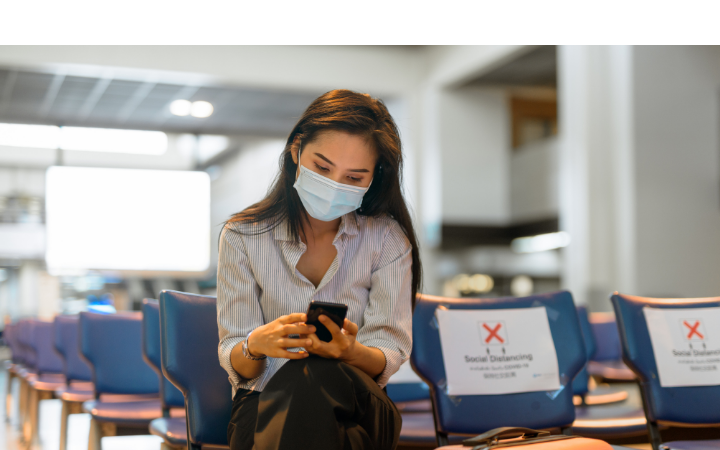Insight
Is your risk management approach future-proof?

The sudden onset of the global pandemic — and the chaos that followed — serve as an important reminder to always be prepared for the unexpected.
Companies across the globe have started to re-evaluate their risk management approach to ensure it’s built to keep their employees safe and travel managers feeling confident that they have the right processes and tools in place.
Speaking with FCM Travel’s Global Safety & Risk Product Leader, Matthew DeMaris, we dive into some key developments happening in the travel risk management space, as well as some best practices companies can implement to ensure their risk management approach is built for the future. Let’s dive in:
Q. The thought of traveling again can seem daunting for both travellers and travel managers having not had much, if any travel, over the past 12 months. From border closures, to testing requirements, to different regulations around the world — there’s so much to absorb. What can TMCs do to help simplify this process and make things easier for travel managers and travelers?
A. It’s all about finding that balance between service offerings and technology to help travellers and travel managers plan, stay informed, and respond effectively to everything from border and movement restrictions to digital health and testing requirements. From a technology perspective, that can come in the form of a desktop application for pre-trip planning. It can also come in the form of automated trip notifications to help keep travellers informed about new and changing risks impacting their trip. For travel managers, it can come in the form of automation – how is the TMC assisting travel managers in simplifying every-day tasks? Are they offering streamlined approval workflows or helping organizations locate and communicate effectively with their travellers?
We’ve seen a tremendous effort by the industry as whole to create new and better technology to help restore confidence in travel. But there’s a people aspect as well – your TMC should be your trusted partner; your industry-insider, if you will.
TMCs and their consulting services should be working with travel managers to optimize their travel program and ensure the health, safety and well-being of travellers at the heart of their risk management strategy. They should also be offering round the clock access to experienced travel advisors so that if circumstances in a destination change, travelers can be first in line to mitigate their risk and return home immediately.
That’s the balance that I think TMCs will need to have in the future to restore confidence in corporate travel and help simplify the travel experience.
Q. How can a company’s relationship with their TMC influence their travel risk management strategy?
A. More than anything, you want a TMC who you can work with — a TMC whose flexibility and expertise in the travel risk management space can help you solve real-world problems. Whether it’s trip monitoring, risk analytics, crisis communications — or whether it’s helping craft a travel policy to reduce trip leakage — having a TMC with that knowledge and expertise can really go a long way.
More importantly, you want trust. Having a TMC that is engaged with risk management companies, travel assistance companies, insurance companies of all shapes and sizes, etc. goes a long way in helping companies find what fits the needs of their program.
Q. With so many new considerations on the horizon, have you seen any companies restructure their risk management division or team as a result? If so, what are some advantages to modifying this structure?
A. Yes – I think that COVID-19 really made it a priority for companies to engage with their travel departments and bridge any remaining gaps between their HR, communications, security, legal, and travel teams. The advantage is that travel and security teams are now realizing the advantages of having a robust travel strategy that allows the company to view and track their travellers’ itineraries, make policy decisions quickly, and help communicate effectively with both their static and mobile workforces.
Q. What about travel policies? Understanding many companies have implemented an interim travel policy over the past year, are there any changes you’ve seen that you recommend are kept long-term?
A. Yes — although I want to say that there is no one-size fits all. We’ve seen companies adopt a number of different policies that fits within their company culture and risk thresholds. The first has to do with pre-trip travel approvals. We’ve seen a lot of companies put in Red Light, Yellow Light, Green Light policies allowing some travelers within the company to travel at will (Green Light) – some to require approval or consider a virtual meeting (Yellow Light) – and some to reconsider all travel (Red Light).
In terms of long-term policies – there have been a lot of changes that I recommend that companies keep long-term. Some policies require that travelers undergo a risk assessment, training, or at the very least must review the risks posed to them at their destination prior to booking their reservation. Even under the circumstance where borders open-up completely, having these assessments and trainings in place for other risks such as civil unrest, natural disasters, and other hazards could be key in restoring corporate traveller confidence.
Most importantly, what COVID-19 has taught companies, and what I recommend that they incorporate into their travel policy long-term, is that circumstances relating to travel can always change, and having a plan in place is really key to emerging from a critical incident successfully.
Q. Let’s talk a bit about digital health passports. What are they and what benefits will they bring from a risk management perspective?
A. Digital Health Passports are the industry’s response to public and private demands that travellers be either tested or vaccinated prior to arrival at their destination. ‘Health Passports’ minus the digital — have existed for years prior to COVID; from MEDA forms to ICVP Immunization cards. The concept is simple at a high-level but can be more complicated the further you dig.
At a high-level, digital health passports are a simple way to store your health information. For example, if your destination requires a PCR test be performed 3 days prior to departure, a digital health passport can help store that information so that you can present it upon boarding and/or arrival. The benefit from a risk management perspective is 1) the digital health passport is a contactless solution. And 2) it can help those who have taken the proper health and safety precautions get to where they need to be and restore confidence that those around them have taken similar precautions.
With all that being said, digital health passes still have a few hurdles to leap over. Accessibility is one of them as not all countries have access to digital devices or applications. Data privacy is another. And lastly, fragmentation and verification. If the industry can agree on a common framework to work off of, and there are some really fantastic organizations working on that right now, then digital health passports do have a chance to really help restore confidence in corporate travel.
Q. And lastly, with vaccine distribution now steadily on the rise, what are some best practices you recommend to clients as they look to build or refine their risk management approach before their travelers get back on the road?
A. Absolutely be making the most of this time to prepare, review and communicate. If I can leave you with 3 takeaways, I'd say:
1. Prepare by having a clear and easily accessible travel policy in place. Be sure that it’s effectively communicated to your travellers so that they know what’s inside of it and where they can access it at any time.
2. Be sure to have a risk management team in place with key stakeholders within your organization so that if changes to travel restrictions, entry/exit requirements, or any other unforeseen circumstance arises, you can consult with your team and effectively communicate with your employees.
3. Talk to your employees — get a sense of some of the pain points they’re going through and use this feedback to reassess and reinforce your travel risk management strategy.
From a product perspective — this is something we’re doing constantly at FCM. Sitting down with our customers, understanding their pain points, and building solutions to solve their everyday problems. That same approach can also be take by travel managers — building organizational resiliency to help mitigate risks in the long-term is the true goal.
